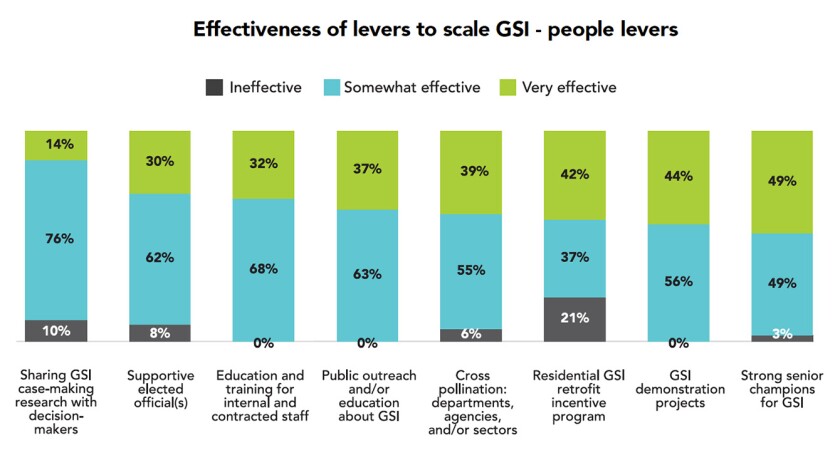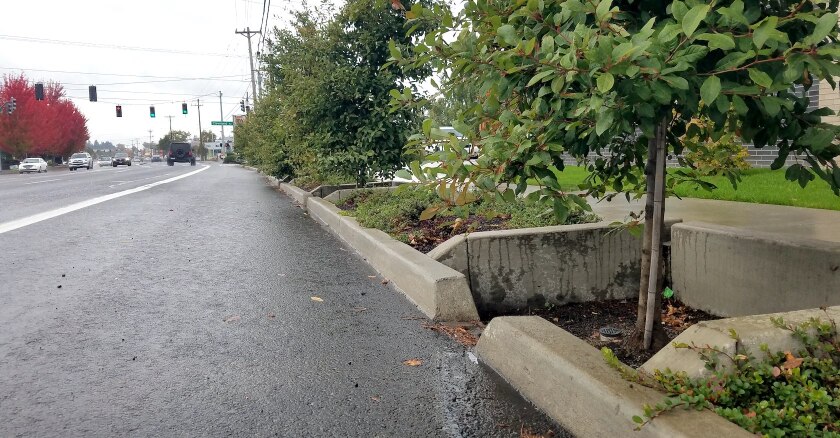In Brief:
Plants, trees and streams may welcome rainfall into their homes, but humans not so much. In the urban areas where 8 out of 10 Americans live, impervious surfaces — rooftops, roads, sidewalks, parking lots — are built above and below to keep water out.
By some estimates, impervious materials cover more than a quarter of all urban land in the U.S. Coverage can vary greatly from city to city; one study of 20 metropolitan areas found a range from about 18 percent to more than 60 percent. Parking lots alone cover more than 5 percent of developed land in the lower 48 states.
This kind of development disrupts natural stormwater storage and discharge systems. In addition, people and businesses sometimes choose to settle in places where stormwater is likely to collect. Gutters, pipes, storm drains and other infrastructure are needed to carry stormwater away from residents.
Concern about water system contamination by material in urban stormwater runoff — bacteria, animal waste, trash, petroleum products, pesticides and other chemicals — dates back more than half a century. Planners first responded with “low impact” strategies to restore and preserve green space, but by the early 21st century a new approach began to emerge: green infrastructure.
The term refers to the use of plants, soils, permeable surfaces, stormwater harvest and other strategies to keep more rain where it falls. The federal Water Infrastructure Improvement Act, which became law in 2019, enabled cities to include green infrastructure in integrated stormwater and wastewater management plans.
The Green Infrastructure Leadership Exchange — or the Exchange for short — a nonprofit association of local government professionals responsible for stormwater management, has just published a report on the state of public-sector green stormwater infrastructure (GSI). It offers an unprecedented look at implementation, best practices, investment trends and drivers for increasing the use of GSI in stormwater management.
“There hasn't been a report like this,” says Barbara Hopkins, executive director of the Exchange. “We wanted to establish a baseline that would help us understand how much has been implemented and create a shared blueprint for how we go forward together.”

(Green Infrastructure Leadership Exchange)
Dry Days and Rain Are Both Increasing
A warming climate is changing the scope and urgency of stormwater management in many communities. Last week, Fort Lauderdale was inundated by almost 26 inches of rain in a 24-hour period.
It was a “1,000-year storm,” meaning that there was a 1 in 1,000 chance it would happen. Last summer, five 1,000-year storms hit the U.S. within five weeks.
These bursts of heavy rain are going to happen more often, says Victor Murphy, a climate service program manager with the National Weather Service. “From a stormwater perspective, the big news with climate change is that total rainfall amounts over the course of a year or two years will likely not change much, but the manner in which it falls will change.”
In many jurisdictions, longer periods with little to no rain will alternate with shorter, more intense rainstorms. That’s bad news for water managers and stormwater systems, Murphy says.

(City of Boston)
Shifting Practice
A 2022 report from Rebuild by Design looks at the role green infrastructure can play in helping New York City adapt to more extreme storms, noting that “a comprehensive citywide plan will only be successful if every agency prioritizes the use of green infrastructure in every investment.”
Kate England, director of green infrastructure for the city of Boston, is better able than most to facilitate such cohesion. Her job is a cabinet-level position in the administration of Mayor Michelle Wu, enabling her to work across city departments.

(Matthew Modoono)
In her new role, she’s requiring every transportation or public works project that changes curb geometry to choose from one of five green infrastructure design alternatives. She’s working with the city’s housing, school and public facilities departments.
As she shifts the practices used by city departments, England is also working to ensure private property owners integrate green infrastructure in their projects. “It's becoming part of our standard as opposed to being a special thing that we do sometimes.”
What Would Nature Do?
Untreated arterial streets are one of the worst pollutant-generating sources, says Torrey Lindbo, the water resources science and policy manager for the city of Gresham, Ore., and the co-chair of the Exchange. His city has a high-traffic arterial covered with a three-inch overlay of permeable material that has become something of a “poster child,” he says.
Lindbo has been collecting data to see how the road is performing. He says that when rainwater filters through the pervious asphalt and over to the side before running off, the pollutants in it have been reduced by more than 90 percent.
“That’s pretty simple — there are no plants growing in it,” says Lindbo. “But it’s not getting implemented on a wide scale in most places.”

(City of Gresham)
Gresham’s green infrastructure also includes streetside planters, stormwater tree wells, bioswales, rain gardens and pond facilities. As they proliferate, Lindbo says it’s important to have a maintenance program that is growing along with them. Weeding, pruning and replanting help build public acceptance and support.
Green infrastructure can reduce runoff from urban areas by mimicking natural processes, but flooding is also a natural process. Development standards also need to take the functions of streams and floodplains into account, says Lindbo.
“We need to stay out of spots that we shouldn’t be in.”
Learning Circles
Investment in GSI has been growing, and projections for the next five years show even greater growth, says Hopkins. The fact that longer dry periods are coming in combination with heavier storms means it’s important to capture more stormwater to replenish groundwater sources.

(Norm Barker)
Green infrastructure has reached a design-worthy standard of practice, says Chuck Louisell, Ph.D., chief artificial intelligence and science officer for True Elements Inc. Louisell attributes the shift to the introduction of the Water Environment Federation Manual of Practice supporting planning, design and performance criteria for green infrastructure. His firm has developed analytic tools to create storm series projections that take climate into account, so that engineers can understand future conditions and can plan for them. (Governing’s parent company, e.Republic, is a partner with True Elements.)
For its part, the Exchange works to foster peer-to-peer learning, Hopkins says, and is open to any public-sector practitioner who wants to participate. Six learning circles meet monthly, and grants are available for them to work with consultants to work out approaches to especially thorny problems.
“Through peer learning, we’re trying to come up with innovations in GSI practice that will advance the whole field,” says Hopkins. “It's a very collegial network of people.”












